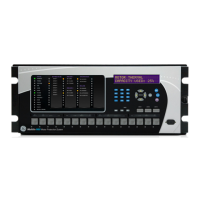CHAPTER 5: SETTINGS SYSTEM SETUP
M60 MOTOR PROTECTION SYSTEM – INSTRUCTION MANUAL 5-147
5
For example, a circuit breaker 52b auxiliary contact is closed when the breaker is open and open when the breaker is
closed. Therefore the setting is "Cont Ip n On." For a 52a contact, the setting is "Cont Ip n Off."
Four mutually exclusive FlexLogic operands that reflect the motor state are generated by a state machine in the relay to
determine motor status. They are MOTOR OFFLINE, MOTOR STARTING, MOTOR RUNNING, and MOTOR OVERLOAD.
The state machine initially sets the MOTOR OFFLINE operand, as the auxiliary contact reports the switching device is open
and motor current is less than 2% of FLA. If the previous motor status is offline, a phase current greater than 2% of FLA is
detected, and the MOTOR OFFLINE operand de-asserts, then the MOTOR STARTING operand becomes true. After one second, if
motor current is less than FLA times the
MOTOR OVERLOAD FACTOR setting, the MOTOR RUNNING operand is set (this accounts
for the use of a soft-starter mechanism that slowly increases current such that it never exceeds FLA × overload factor
during a starting sequence). For normal starting, the MOTOR STARTING operand remains set until the current falls below FLA
× overload factor, at which time the MOTOR RUNNING operand is set. If current rises above FLA × Service Factor at that point,
the MOTOR OVERLOAD operand is set. If current then falls below FLA × overload factor, the MOTOR OVERLOAD operand is reset
and the MOTOR RUNNING operand is set. A MOTOR OFFLINE state is determined per the logic noted.
When two-speed motor functionality is employed, this setting is used to indicate the breaker or contactor position at
speed 1. As such, the speed 1 auxiliary contact is connected to the input specified by this setting for two-speed
applications.
EMERGENCY RESTART — As the name implies, this feature i s only used in an emergency, as it defeats the purpose of the
relay—protecting the motor. The input selected by this setting is used to reset the motor thermal capacity used from its
current value to 0% so that a hot motor can be restarted. However, trip conditions that are still present (for example, hot
RTD) still cause a trip. In the event of a real emergency, the EMERGENCY RESTART operand should remain at logic 1 until the
emergency is over. Any EMERGENCY RESTART operand transition is logged as an event.
MOTOR LINE SOURCE — This setting selects the source connected to phase current transformers on the power system side
of the stator winding.
NUMBER OF STARTS TO LEARN — This setting selects number of motor start and stop records to average data presented in
the
ACTUAL VALUES RECORDS MOTOR LEARNED DATA menu.
MOTOR LOAD AVERAGE CALC. PERIOD — This setting specifies the period of time over which parameter averages are
calculated. The calculation is a sliding window.
2-SPEED MOTOR PROTECTION — This setting enables/disables the two-speed motor function. This function provides proper
protection for a two-speed motor where there are two different full load values. The two-speed functionality is required for
motors having two windings wound into one stator. One winding, when energized, provides one of the speeds. When the
second winding is energized, the motor takes on the speed determined by the second winding. The M60 algorithm
integrates the heating at each speed into one thermal model using a common thermal capacity used register value for
both speeds. Using the M60 for such applications provides several options, allowing the removal of traditional wiring and
interlocking:
• Use the M60 front panel pushbuttons and provide necessary operate and interlock logic via FlexLogic
• Use external pushbuttons and provide necessary operate and interlock logic using FlexLogic shown as follows
• Use a traditional external control schematic with some connections to the M60 for control and protection
SPEED2 MOTOR SWITCH — If the two-speed motor feature is used, this setting specifies a FlexLogic operand to indicate the
current motor speed. This is typically an indication that the contactor at speed 2 is energized. When the assigned FlexLogic
operand (typically a contact input operand) is asserted, the algorithm switches to speed 2 (high speed). If the assigned
FlexLogic operand is de-asserted, the algorithm switches to speed 1 (low speed). This allows the M60 to determine which
settings are to be active at any given time. To maintain correct motor status indication, the M60 expects a transition from
speed 1 to speed 2 within two seconds; otherwise, the motor status value can be reset.
SPEED2 SWITCH 2-1 DELAY — This setting specifies the time delay to transfer from high to low speed. This allows the motor to
slow down before energizing at low speed.
SPEED2 MOTOR SOURCE — This setting selects source for a motor protection when two-speed motor functionality is used.
This can be separate voltage and current banks or one voltage and current bank one with different full load current value
at the second speed (entered in the
SPEED2 MOTOR FLA setting). If separate CTs with different ratios or secondary currents
are required for speed 2, then order the relay with two CT banks.
SPEED2 MOTOR FLA — This setting specifies the motor full load current for speed 2.

